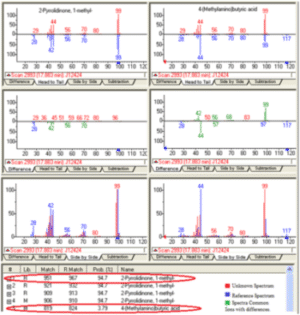The National Institute of Standards and Technology, or NIST, is one of the nation’s oldest physical science laboratories founded in 1901. This organization has collected electron ionization (EI) gas chromatography (GC) mass spectral data of known standards from various sources to create a mass spectral reference library of compounds. This library is used all over the world for the identifications of unknowns in GCMS chromatograms.
NIST uses the submitted unknown spectrum collected by mass spectrometer detectors (MSD) and performs a library spectrum search. The mass spectral data is analyzed against all the library spectra and calculates three numbers associated with each compound. The three numbers are: Match Factor (Match), Reverse Match Factor (R. Match), and Probability (%). These numbers are used to create a hit list of compounds that NIST has identified as possible matching chemical structures. This whitepaper discusses these three factors and how they affect chemical identification.





